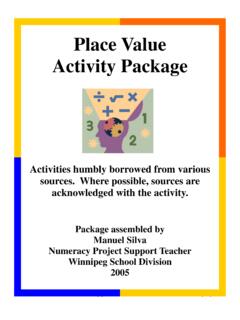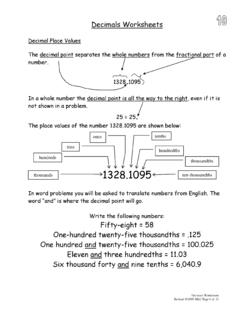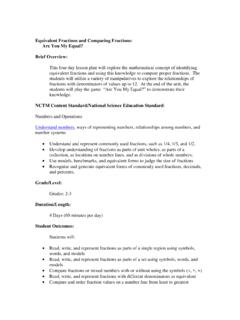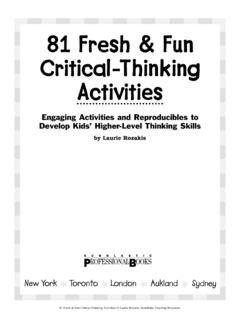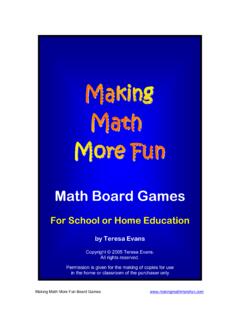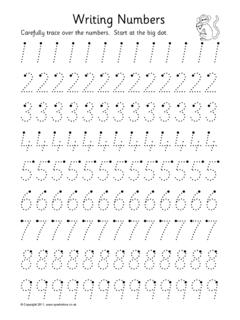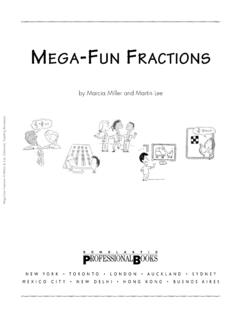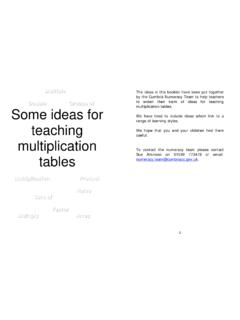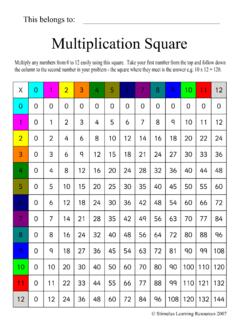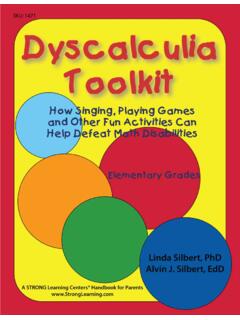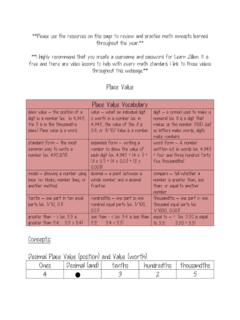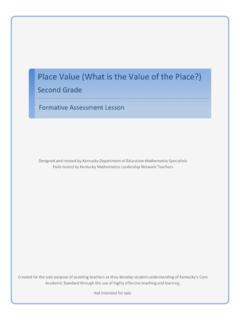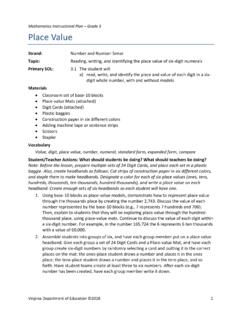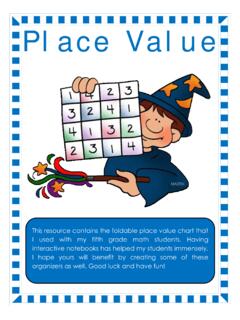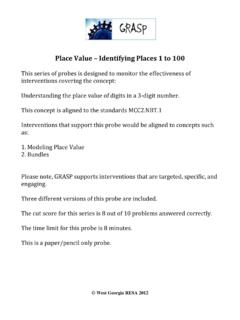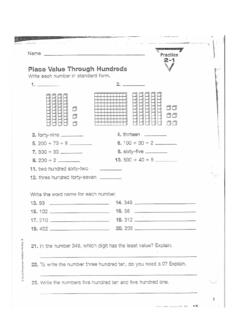Transcription of Place Value Made Simple - Mathematics Shed
1 Title: Place Value made Simple Brief Overview: This concept development unit will provide students with the knowledge and understanding of Place Value of whole numbers (0 - 1,000,000). Students will be able to read, write, and represent whole numbers using symbols, models, and words. Students will also express whole numbers in expanded form. NCTM Content Standard/National Science Education Standard: Numbers and Operations Understand numbers, ways of representing numbers, relationships among numbers, and number systems o Understand the Place - Value structure of the base-ten number system and be able to represent and compare whole numbers and decimals Grade/Level: Grade 3: Read, write, and represent whole numbers 0 10,000 Grade 4/5: Read, write, and represent whole numbers 0 1,000,000 Duration/Length: 60 minutes per lesson 20 minutes for summative assessment Student Outcomes: Students will.
2 Read, write, and represent Place Value of whole numbers using models and symbols Read, write, and represent whole numbers in standard form, expanded form, and word form Materials and Resources: Lesson 1 Place Value Pocket Chart for each student (Refer to Teacher Resource 1a for directions) Large Place Value Pocket Chart 1 set of Number Cards (0-9), Teacher Resource 1c, for each student Base Ten Blocks Transparencies of Teacher Resource 2a and 2b, Would you rather Sentence strips with vocabulary words: Ones Period, ones, tens, hundreds (purple sentence strip or purple writing) Thousands Period, one thousands, ten thousands, hundred thousands (green sentence strip or green writing), Millions Period, one millions (red sentence strip or red writing) One die for each student Place Value Folder for each student in re-teach group (Refer to Teacher Resource 4 for directions) Copies of Teacher Resource 3, Place Value 1 Checklist, to record observations Copies of Student Resource 1a and 1b, Rolling with Place Value (class set) Copies of Student Resource 2, What s the Largest?
3 , for early finishers Overhead marker for each student in re-teach group Lesson 2 Base Ten Blocks 1 rubber band Large Place Value Pocket Chart Sentence strips with vocabulary words: standard form, word form, expanded form Copies of Teacher Resource 3, Place Value 2 Checklist, to record observations Expanded Form Accordion, Teacher Resource 5 Transparency of Student Resource 3, Check Writing Laminated check for each student, Student Resource 3, Check Writing One baggie with pre-cut cards for each pair of students, Student Resource 4, Shopping Spree Copies of Student Resource 5, Another Shopping Spree, for early finishers Place Value Pocket Chart for each student in re-teach group (Refer to Teacher Resource 1a for directions)
4 1 set of Number Cards (0-9), Teacher Resource 1c, for each student in re-teach group Summative Assessment Copies of Student Resource 6a and 6b, Place Value of Whole Numbers (class set) Development/Procedures: Lesson 1 Pre-Assessment Provide students with pre-assembled pocket Place Value charts. Refer to Teacher Resource 1a, Directions for Pocket Place Value Chart. Model where students should write the labels on the Place Value chart. Have students label the periods and places on the Place Value chart based on their previous knowledge of Place Value . Place pocket Place Value charts on the corner of students desks.
5 Inform students that they will be discussed later in the lesson. Launch Engage students in the Would You Rather activity. Display the top portion of Teacher Resource 2a, Would You Rather , on the overhead with only the question displayed: Would you rather have 6 Playstation games or 60 Playstation games? Have students raise their hand if they would rather have 6 Playstation games. Then, have students raise their hand if they would rather have 60 Playstation games. Ask students to explain their reasoning. Guide students to see the relationship between Place and Value .
6 The Place of a digit within a number is important because it tells us the Value of that digit. Display the bottom portion of Teacher Resource 2a to provide a visual of the Value of 6 Playstation games and the Value of 60 Playstation games. Continue the Would You Rather activity as stated above using Teacher Resource 2b. Discuss the importance of the relationship between Place and Value . The amount of pennies shown is the actual amount of pennies. Graphic of pennies was taken from the website, Refer to the objective and discuss with students that today they will be working with Place Value of whole numbers.
7 Teacher Facilitation Write the number 583 on the board and use the Think Aloud strategy to model how to represent the number using base ten blocks. Think Aloud: I know that the 3 is in the ones Place , so I will represent that digit with 3 units. Count the units to demonstrate that there are 3. I know that the 8 is in the tens Place , so I will represent that digit with 8 rods. Skip-count the rods by 10 to demonstrate that there are 80 units. I know that there is a 5 in the hundreds Place , so I will represent that digit with 5 flats. Skip-count the flats by 100 to demonstrate that there are 500.
8 Let s see if we really have 583. Begin counting the flats: 100, 200, counting the rods 510, 520, continue counting the units 581, 582, 583. I can represent the number using the models to help me see the Value of the number. Distribute Base 10 Blocks to all students. Display a number on the board, and ask the students to represent the number at their desks using the base ten blocks. Determine the amount of practice students will need representing numbers using base ten blocks, based on teacher observations. Provide additional practice as needed. Display an enlarged pocket Place Value chart that is not labeled.
9 Tell the students that they will represent larger numbers using a Place Value chart. Have students move their pocket Place Value chart in front of them. Distribute sentence strips with vocabulary words to students. Call students to the board to label the large Place Value chart in the following order: Ones Period, ones, tens, hundreds, Thousands Period, one thousands, ten thousands, hundred thousand, Millions Period, one millions. Ask students if they know the other places in the millions period (ten millions and hundred millions). Distribute baggies with precut labels and number cards to students, (Teacher Resource 1b, Pocket Place Value Chart Labels.)
10 Have students glue the labels on their pocket Place Value charts to match the class chart. Have the students write a zero on the back of each number card. Restate that the Place of a digit in a number tells the Value of that digit. Base ten blocks were used to see the Value of each digit. Use the Place Value chart as another strategy. Model by correctly placing each digit of the number 372 in the displayed large pocket Place Value chart. Display 2 units, 7 rods, and 3 flats above each digit in the pocket chart as you Place each digit in the pocket. Explain to students why each digit was placed in its corresponding pocket.
